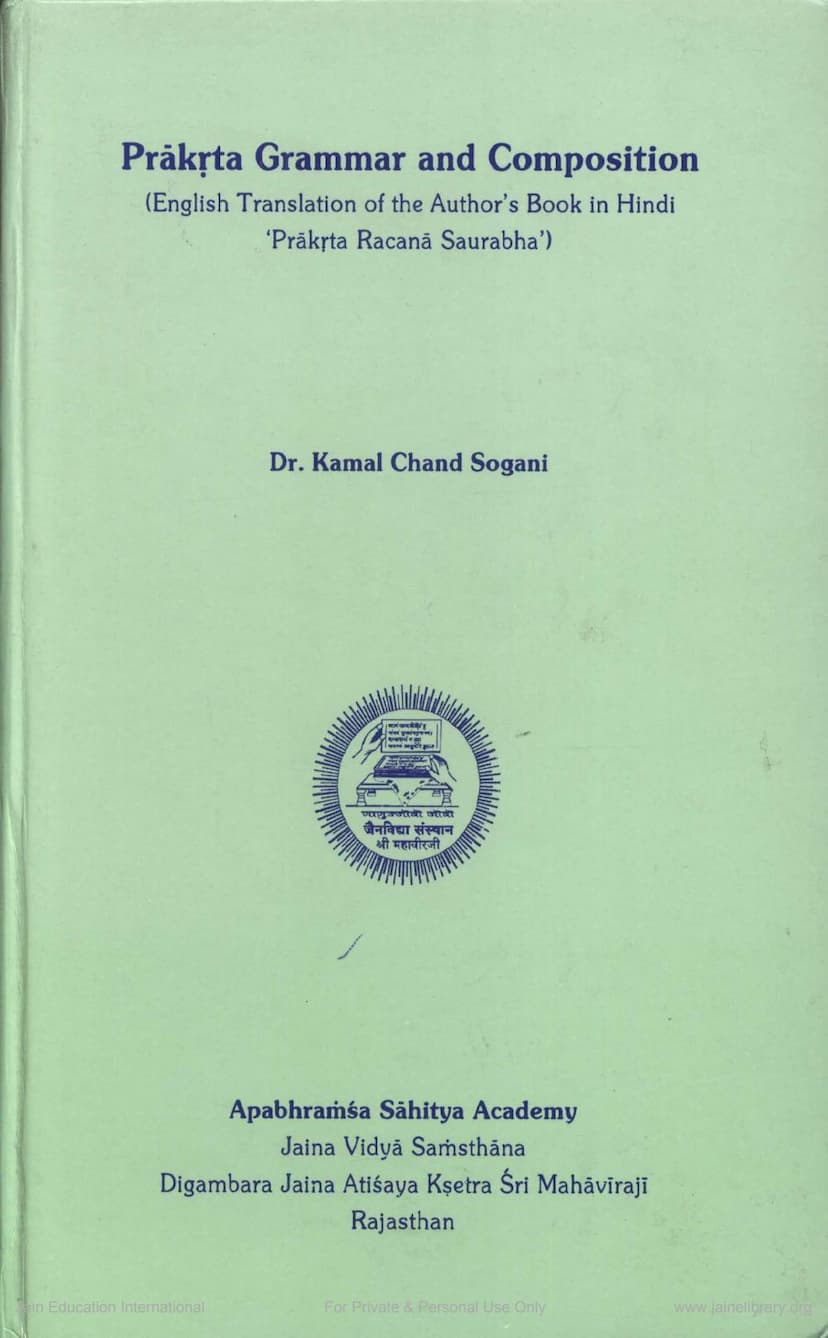Prakrit Grammar And Composition
Added to library: September 2, 2025

Summary
Here's a comprehensive summary of the Jain text "Prakrta Grammar and Composition" by Dr. Kamal Chand Sogani, based on the provided table of contents and introductory pages:
Book Title: Prakrta Grammar and Composition Author: Dr. Kamal Chand Sogani Publisher: Apabhraṁśa Sahitya Academy, Jaina Vidya Samsthāna, Sri Mahaviraji, Rajasthan Original Hindi Title: Prakrta Racana Saurabha (This is an English translation of the second edition of the Hindi book). Purpose: To teach Prakrta language and composition to English-speaking learners.
Overview:
"Prakrta Grammar and Composition" is a detailed guide to the Prakrta language, presented as an English translation of Dr. Kamal Chand Sogani's Hindi work. The book aims to provide a systematic and comprehensive understanding of Prakrta grammar and its application in composition. It covers the fundamental elements of the language, from its alphabets and grammatical categories to verb conjugations, noun declensions, and various participial forms. The text emphasizes the importance of Prakrta in India's cultural history, noting its role as the language of the masses, its connection to Jain and Buddhist traditions, and its influence on modern Indian languages.
Key Features and Content:
The book is structured into numerous lessons, each focusing on specific aspects of Prakrta grammar:
- Introduction to Prakrta: The initial pages highlight Prakrta as a rich, ancient, and sacred Indo-Aryan language, serving as the mother tongue of Mahavira and Buddha. It emphasizes its significance as the language of the masses and its crucial role in the development of Indian languages and literature.
- Alphabets and Phonetics: The text details the vowels and consonants of Prakrta, including diacritical marks used for pronunciation.
- Grammatical Categories: The book systematically explains Prakrta's grammatical features:
- Number: Singular and Plural.
- Gender: Masculine, Feminine, and Neuter.
- Person: First, Second, and Third Person.
- Case: Eight cases are presented: Nominative, Accusative, Instrumental, Dative, Ablative, Genitive, Locative, and Vocative.
- Verb Types: Transitive and Intransitive verbs.
- Tenses: Present, Past, Future, and Imperative.
- Word Types: Categorized by their endings: a-ending, i-ending, á-ending, and u-ending.
- Verb Conjugations: A significant portion of the book is dedicated to verb conjugations across different tenses and persons. The lessons systematically cover:
- Present Tense: Lessons 1-8 detail the present tense conjugations for first, second, and third persons, singular and plural, including variations for non-'a'-ending verbs.
- Imperative: Lessons 9-16 cover the imperative mood for all persons and numbers, again distinguishing between 'a'-ending and non-'a'-ending verbs.
- Past Tense: Lessons 17-18 explain the past tense formation for singular and plural subjects with both 'a'-ending and non-'a'-ending verbs.
- Future Tense: Lessons 19-26 provide a thorough explanation of future tense conjugations, covering all persons, numbers, and verb types.
- Participles: The book dedicates several lessons to various types of participles and their usage:
- Absolutive (Lesson 28): Explains the formation and use of absolutive participles, indicating an action completed prior to another.
- Infinitive (Lesson 29): Covers infinitive forms used to express purpose or intention.
- Past Participle (Lessons 42, 45, 57): Discusses the use of past participles in the active voice, impersonal form, and passive voice.
- Present Participle (Lesson 43): Details the formation and usage of present participles in masculine, neuter, and feminine genders, showing their agreement with nouns.
- Obligatory and Potential Participle (Lessons 49, 62): Explains these participles and their use in the impersonal form (active) and passive voice (transitive verbs), indicating obligation or potential.
- Causative Participles (Lesson 78): Covers causative forms of past, present, obligatory, potential, absolutive, infinitive, and other participles.
- Nouns and Pronouns: The book systematically presents the declension of nouns and pronouns in different cases (Nominative, Accusative, Instrumental, Dative, Genitive, Ablative, Locative, Vocative) and numbers (Singular, Plural) across various gender classes (i-ending, u-ending masculine, neuter, feminine). Appendices provide comprehensive noun and verb indexes.
- Transitive Verbs and Voice: Lessons 51-57 focus on transitive verbs, explaining their use in active and passive voice, with particular attention to case usage in sentences. The formation of passive voice from transitive verbs is detailed, along with the use of past participles in the passive voice.
- Impersonal Forms: Lessons 47-48 explain the impersonal use of intransitive verbs and obligatory/potential participles.
- Causative Verbs: Lesson 78 and related sections delve into the formation of causative verbs, their use in active and passive voices, and their application in various participial forms.
- Indeclinables (Lesson 81): Identifies and explains the usage of words that do not change their form regardless of case, number, or gender.
- Conjugation Tables (Lesson 82): Provides summary tables of verb endings for present, imperative, and future tenses.
- Declension Tables (Lesson 84): Offers comprehensive tables for the declension of various noun and pronoun types, following Hemacandra's grammar.
- Exercises: Each major section includes exercises to reinforce learning, such as translation, sentence correction, and filling in blanks.
Target Audience:
This book is designed for individuals who wish to learn the Prakrta language, particularly those with an English language background. It is also valuable for researchers and scholars interested in Prakrta literature, Jainism, Buddhism, and the history of Indian languages.
Key takeaway:
"Prakrta Grammar and Composition" is a thorough and accessible textbook that systematically guides learners through the intricacies of the Prakrta language, making it a foundational resource for understanding this important ancient Indian language.